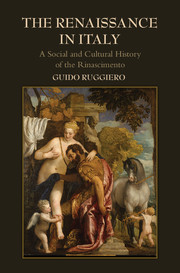Book contents
- Frontmatter
- Dedication
- Contents
- List of Illustrations
- Acknowledgments
- Maps
- Introduction: The End of the World and Its Rebirth (Rinascita) as the Rinascimento
- 1 Legitimacy: A Crisis and a Promise (c. 1250–c. 1340)
- 2 Civiltà: Living and Thinking the City (c. 1300–c. 1375)
- 3 Plague: Death, Disaster, and the Rinascita of Civiltà (c. 1325–c. 1425)
- 4 Violence: Social Conflict and the Italian Hundred Years’ War (c. 1350–1454)
- 5 Imagination: The Shared Primary Culture of the Early Rinascimento (c. 1350–c. 1475)
- 6 Courts: Princes, Aristocrats, and Quiet Glory (c. 1425–c. 1500)
- 7 Self: The Individual as a Work of Art (c. 1425–c. 1525)
- 8 Discovery: Finding the Old in the New (c. 1450–c. 1560)
- 9 Re-Dreams: Virtù, Saving the Rinascimento, and the Satyr in the Garden (c. 1500–c. 1560)
- 10 Reform: Spiritual Enthusiasms, Discipline, and a Church Militant (c. 1500–c. 1575)
- 11 Retreat: The Great Social Divide and the End of the Rinascimento (c. 1525–c. 1575)
- Epilogue: The Diaspora of the Rinascimento
- Bibliography: A Short List of Works Used
- Index
Epilogue: The Diaspora of the Rinascimento
Published online by Cambridge University Press: 05 December 2014
- Frontmatter
- Dedication
- Contents
- List of Illustrations
- Acknowledgments
- Maps
- Introduction: The End of the World and Its Rebirth (Rinascita) as the Rinascimento
- 1 Legitimacy: A Crisis and a Promise (c. 1250–c. 1340)
- 2 Civiltà: Living and Thinking the City (c. 1300–c. 1375)
- 3 Plague: Death, Disaster, and the Rinascita of Civiltà (c. 1325–c. 1425)
- 4 Violence: Social Conflict and the Italian Hundred Years’ War (c. 1350–1454)
- 5 Imagination: The Shared Primary Culture of the Early Rinascimento (c. 1350–c. 1475)
- 6 Courts: Princes, Aristocrats, and Quiet Glory (c. 1425–c. 1500)
- 7 Self: The Individual as a Work of Art (c. 1425–c. 1525)
- 8 Discovery: Finding the Old in the New (c. 1450–c. 1560)
- 9 Re-Dreams: Virtù, Saving the Rinascimento, and the Satyr in the Garden (c. 1500–c. 1560)
- 10 Reform: Spiritual Enthusiasms, Discipline, and a Church Militant (c. 1500–c. 1575)
- 11 Retreat: The Great Social Divide and the End of the Rinascimento (c. 1525–c. 1575)
- Epilogue: The Diaspora of the Rinascimento
- Bibliography: A Short List of Works Used
- Index
Summary
In August of 1572, as the infamous slaughter known as the Saint Bartholomew’s Day Massacre raged in France, in Lyon an Italian printer working in the city, Alessandro Marsigli, apparently took advantage of the uproar to murder an Italian merchant, Paolo Minutolo. Although the religiously driven massacres probably killed between ten and twenty thousand people, Paolo’s murder was not motivated by confessional differences. Rather, it seems that Alessandro hoped to use the murder of Minutolo, banned from Lucca, to win a pardon for his own crimes and to be allowed to return to Italy from exile. Alessandro’s hopes were apparently based on the fact that Italian governments regularly offered pardons to those who dispatched criminals who had fled and been placed under a ban. If that was Alessandro’s motivation, it was thwarted by the fact that the authorities in Lyon were not particularly enthusiastic about supporting Italian justice by overlooking murder in their city; for we know of his crime only because the authorities there prosecuted him, creating a trial record that Natalie Z. Davis cited in a footnote to her path-breaking book, Society and Culture in Early Modern France.
Suggestively, in her many studies of Lyon in the sixteenth century Davis often referred to the Italians who were living in the city: silk workers, who had played an important role in founding the industry there and sustaining it; printers, who were signii cant in establishing the city as an important center of printing; bankers, who had helped make the city a major financial center; along with merchants of all types, lawyers, bureaucrats, and ecclesiastics.
- Type
- Chapter
- Information
- The Renaissance in ItalyA Social and Cultural History of the Rinascimento, pp. 575 - 590Publisher: Cambridge University PressPrint publication year: 2014



